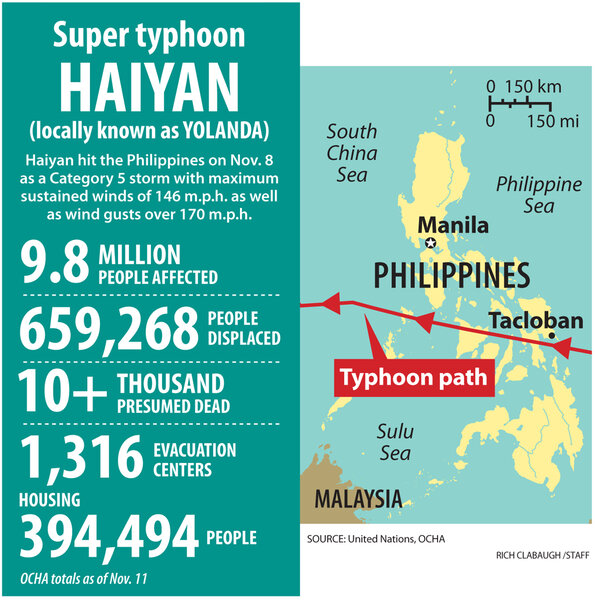Typhoon Haiyan: Was The Philippines prepared?
Loading...
| Taipei, Taiwan
Death and damage on an island in The Philippines after one of the worst typhoons on record has sparked a search for explanations as to why an archipelagic nation that's no stranger to big storms wasn't better prepared for Typhoon Haiyan.
But experts say it's hard to point fingers in a country that's had a rapidly growing population along its coast and increasingly frequent large storms.
“A lot of the problem is that you have good preparation, good laws, a lot of good intentions, but it kind of falls apart when the rubber hits the road,” says Leonard Doyle, Philippine-based head of online communication for the International Organization for Migration
“They’re getting more extreme weather, and it is more unpredictable,” says Mr. Doyle, whose organization helps resettle displaced people. “I don’t think you can point the finger at any one person and say it’s because of corruption.”
Government officials are under pressure to deal with not just each each storm emergency but also broader problems such as warming planet and the rapid expansion of shanty towns, where rickety homes are particularly vulnerable to storm damage.
Questions about disaster preparedness came shortly after Typhoon Haiyan made landfall on Friday, killing an estimated 10,000 people and causing billions of dollars in damage. The storm also flattened much of Tacloban City, home to 220,000 people. Tacloban is on Leyte Island and is about 500 miles southeast of Manila, which is on the island of Luzon.
Philippine President Benigno Aquino III expressed disappointment with preparations for Haiyan, according to the Manila Bulletin newspaper.
“Definitely the local governments are not prepared,” says Ramon Capisle, executive director at the Metro Manila-based Institute for Political and Electoral Reform. “They underestimated the strength of the typhoon. They should have done the maximum preparations.”
But the president’s reaction to the storm has sparked an angry rebuke from locals and their lawmakers in Leyte, an eastern province considered ground zero for typhoon damage. Lawmakers asked that the government exercise more control over looting of scarce food supplies.
Hundreds of thousands of people evacuated as authorities sounded warnings ahead of the typhoon, says Philippine Red Cross Secretary General Gwendolyn Pang. But warnings missed the deadliest element of the typhoon – storm surges that brought sea waves of up to 17 meters (55 feet), enough to cause flooding hundreds of meters inland.
“In all fairness, people had prepared. They evacuated three days before it happened,” Ms. Pang says. “People should be told that the typhoon may lead to a storm surge of what type of wave, how strong.”
The Philippines has over 1,000 miles of coast on its eastern shores, and the absence of any meaningful land masses to protect the country to the east leaves it vulnerable to the typhoons that come storming out of the Western Pacific in the second half of most years. Storms have been slightly more numerous than normal this year – a relatively light one is headed for the southern island Mindanao – because of unusually warm waters in the Pacific, says forecasting website Tropical Storm Watch 2013.
The website expects between four to six storms in the Western Pacific this month and more in December, with as many as seven super-typhoons.
Population growth of around 2 percent since 2000, more than the world rate of 1.14 percent, has hobbled disaster prevention as people build shanties near fisheries and farms.
Slightly more than a quarter of the country's 98 million people live below the government-set poverty line, and some estimates place a quarter of Manila’s population in shanties, often near water.
Typhoon relief efforts aimed at the 1 million displaced are focused now on food, water and security in the face of looting, Ms. Pang says, noting that the Red Cross is short of its immediate goal for $17 million in donations. In the future, Mr. Aquino will get down to “improving preparation strategies” to save lives, the Manila Bulletin says.









